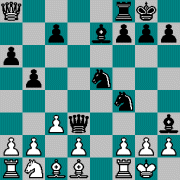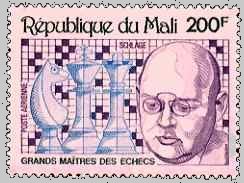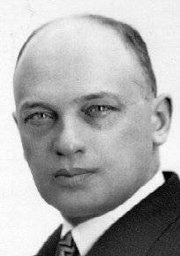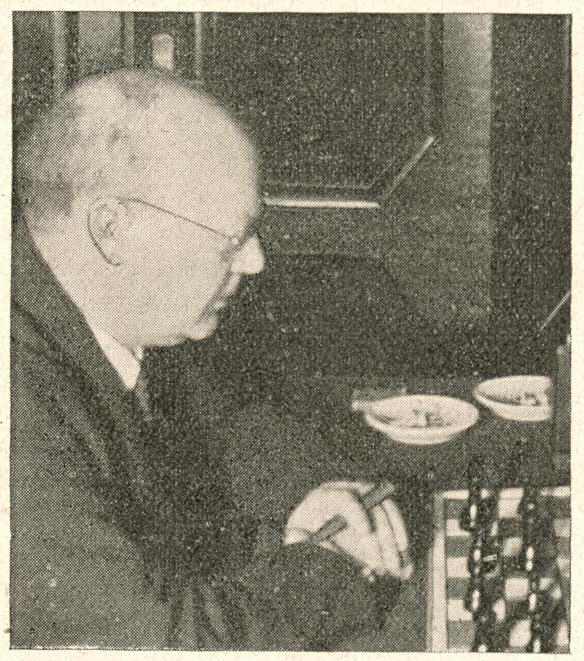The only unknown to become immortal twice.
When Stanley Kubrick died recently (7 March 1999) there was of course, in chess circles and newsgroups, talk of his interest in chess. He is supposed to have been a keen player in his youth, playing for stakes in Washington Square Park in his birthplace New York, and to have played on the sets of his movies. But especially there was talk of the chess in his famous movie 2001: A Space Odyssey (1968). Early in that movie, there is a briefly passing character whose name is Dr. Smyslov and later Frank Poole, one of the astronauts on board of the spacecraft, plays its computer HAL.
 White to play
White to play
'Frank Poole - HAL' |
"Yeh. Yes, looks like you're right," says Poole, acknowledging his defeat. "I resign."
"Thank you for a very enjoyable game," says HAL.
"Thank you too," says Poole.
Much has been made, between Kubrick exegetes, of the way HAL plays Qf3 - saying: 'Queen to bishop three,' when he should have said 'Queen to bishop six.' The theory is that Kubrick, who was a maniac about details, and an expert chessplayer, could not have made this mistake unintentionally, and that it therefore means something: HAL was testing Poole, secretly rejecting him when he let Q-B3 pass for Qf3.
It's possible, but I have my doubts. One thing is that the acceptance of the queen sacrifice, which HAL gives as the only variation, should seem bad to a computer; White can stave off the mate for two more moves with Qe6 or Qh6.
And look at the game Kubrick chose for Poole - HAL:
Roesch - Schlage, Hamburg Hauptturnier B 1910
1.e4 e5 2.Nf3 Nc6 3.Bb5 a6 4.Ba4 Nf6 5.Qe2 b5 6.Bb3 Be7 7.c3 O-O
8.O-O d5 9.exd5 Nxd5 10.Nxe5 Nf4 11.Qe4 Nxe5 12.Qxa8 Qd3 13.Bd1 Bh3 (see
diagram) 14.Qxa6 Bxg2 15.Re1 Qf3 16.Bxf3 Nxf3 mate
Some sources erroneously give the year as 1913, and some say White
resigned after 15...Qf3. Kubrick is supposed to have found this game in
Irving Chernev's 'The 1000 Best Short Games of Chess'. But precisely his
choice of this game suggests that he may not have been that knowledgeable
a chessplayer. It's a plain game, and indeed a player who would be impressed
by that Queen's sacrifice, might be weak enough to make a mistake in its
descriptive notation.
Or did Kubrick choose Roesch - Schlage for some
hidden meaning in the winner's name? The German 'schlagen' means 'to hit',
'to beat' or, in chess, 'to capture' - 'I beat you' could be translated
with: 'Ich schlage dich'.
Be that as it may, Space Odyssey has immortalized Schlage. He will live
on in that game as long as Kubrick's films will be viewed - centuries.
An unlikely figure for such a claim to fame; Willi Schlage (1888-1940)
was, in the pre-war years, a German player of second-level prominence.
You come across his name in old German combination books, more often as
the loser than as the winner, and in a few German tournaments, more often
near the bottom than near the top.
That makes it even stranger that when the African
Republic of Mali emitted a set of four  chess
stamps in 1979, under the title 'Grands Maîtres des Échecs', it included
a 200 francs stamp of Schlage, taking a good second place behind Bogoljubow
(300 francs), but leaving 'Aljechin', at 140 francs, and Janowsky (100)
behind him - the best result of his career.
chess
stamps in 1979, under the title 'Grands Maîtres des Échecs', it included
a 200 francs stamp of Schlage, taking a good second place behind Bogoljubow
(300 francs), but leaving 'Aljechin', at 140 francs, and Janowsky (100)
behind him - the best result of his career.
Even apart from Schlage, this is an interesting
set. Janowsky and Bogoljubow were strong grandmasters, but even if limited
to dead masters, I would, had I been Mali, have preferred other greats
for my stamps.
What could be behind that? Something not quite kosher,
you might think. The inclusion of Schlage, and the spelling "Aljechin"
(on a French-speaking stamp; internationally, Alekhine is used,
as he spelled his name himself after he became a French citizen) suggest
the set must have been designed by a German.
In the war, Alekhine published his infamous anti-semitic articles in a Nazi-paper. About Janowsky nothing bad can be said, but Bogoljubow, a born Russian who became a naturalized German, demanded a swastika-flag on his playing table as early as 1938, and he was Reichstrainer for the Greater Germany Chess Federation under the Nazi's. Willi Schlage
held that function too.
Now what could Kubrick have meant by that?
© Tim Krabbé 1999
With thanks to Colin Rose ('Chess on Stamps'), Nico van der Plas and Yoram Lubianiker.
 PS 31 July 2007: Jim Kulbacki informs me that the Mali stamps were designed by the French designer Claude Andreotto (http://www.andreotto.com) and that on the Bogoljubow stamp, his name is misspelled as Bogoljulow. Not too surprising; I have at least a dozen chess and cycling stamps with misspelled hero's names, and I'm not even a collector.
PS 31 July 2007: Jim Kulbacki informs me that the Mali stamps were designed by the French designer Claude Andreotto (http://www.andreotto.com) and that on the Bogoljubow stamp, his name is misspelled as Bogoljulow. Not too surprising; I have at least a dozen chess and cycling stamps with misspelled hero's names, and I'm not even a collector.
This mistake however, Kulbacki writes, "leads me to believe that the designer made another error when he engraved "SCHLAGE" on the stamp. The portrait, in my opinion, bears an uncanny resemblance to Tartakower."
I'm not sure I would call it uncanny, but I agree there's a resemblance between the face on the stamp and this well-known photograph of Tartakower. Of course Tartakower would belong in a series "Grand Maitres des Echecs", but if it is him on the stamp, then that just heightens the mystery of how Schlage's name ended up there.
I could only find one picture of Willi Schlage on the internet, which you can see at the ChessBase site (you have to scroll down a bit). We don't see much of him, but he does look a bit like Tartakower, and he appears to be wearing his Mali stamp glasses.
PS 1 August:
 Thanks to Edward Winter of Chess Notes, who sends me a clearer picture of Schlage.
Thanks to Edward Winter of Chess Notes, who sends me a clearer picture of Schlage.
Top of the page | Main
chess page | Main page